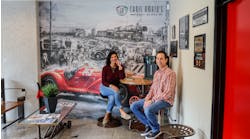Such perceptions can be far from true. Case in point: The Larry H. Miller Collision Center in Peoria, Ariz. This shop is a well-oiled machine, repairing an average of 120 vehicles of week and often more than 500 in a month. But far from being an impersonal, repair factory, Larry H. Miller prides itself on being a dynamic enterprise built around people and focused on a family environment.
Managing any shop with more than 50 employees and hundreds of vehicles passing through its doors each month is a significant challenge. Doing so while creating a personal atmosphere in which each employee feels important and motivated can seem impossible at first. Larry H. Miller manages the high work flow using an operation model that breaks its workload into manageable parts, which are then divided up into specific work roles into which individuals are empowered to take charge.
Production manager Mike Kist calls the model a body shop within a body shop. At Larry H. Miller, each of the shop’s eight estimators leads a separate, dedicated technician team and painters who handle the jobs written up by that estimator, who schedules each customer, controls the workload and decides what work is assigned to which technicians and painters.Kist explains that because each estimator is intimately familiar with his workload and team capabilities, he’s fit to handle his own work and assist other estimators when heavy workloads require assistance from techs and painters outside their respective teams. Outside the eight teams, Kist, shop director Larry Crouse and manager Kevin Gaines, help coordinate work to ensure production is as cohesive and organized as possible.
Along with allowing the shop to handle repairs most efficiently, this setup builds team spirit and creates competition between individual teams.
“Our estimators work individually to attract and build their DRP business,” Kist says. “Other estimators see the one building up insurer customers. They want to help that estimator because they know it will grow our business. But they also want to compete and build their own business. It ends up working out for everyone.”
Along with the competition between estimators, the structure creates internal healthy competition among teams to see which can outperform the other, Kist says.
These factors continually drive productivity because they provide constant motivation for employees to work together inside their individual teams and together as one larger team. Employees have the opportunity to reach team goals while acknowledging a common goal for the business.While teamwork is at the center of the model, it works because of the contributions of each team member.
“All of our employees are integral to making this work,” Kist says. “Our success lies with each individual. With the amount of work and number people involved, it’d be impossible for any one person to control everything. It comes down to the individual knowing his job, controlling things on an individual basis. We couldn’t do what we do if every employee didn’t understand their roles and appreciate the work done by everyone else.”
Employees are able to provide such significant contributions because they’ve worked for the business for so long. One painter has been with the shop for 30 years. Of the shop’s technicians, eight have worked at the shop for 10 or more years. Six others have between five and 10 years service. Kist expects all of them to remain with the business.
Kist attributes the family environment to owner Larry Miller’s ability to evaluate job candidates for the proper character qualities, Miller’s devotion and core values, something many shops have forgotten, he says.
“Many of our competitors have been thinking out of the box for so long, they’ve forgotten what the box is,” he says. “While other shops are looking to change things, often just for change’s sake, we’re looking within the business. We want to grow from the inside out.”
That means adding employees who will be a fit for the shop and its values. As a result, new hires frequently are friends of current employees.
“We value friendship,” he says. “We’re not necessarily looking for all employees to have close bonds and be hanging out with each other after work. We want them to be working in the family environment Larry Miller envisioned when he started this company 30 years ago.”
Competition, pulling together to meet goals, forming bonds – that sounds like family.


